Page 398 - วารสารกฎหมาย ศาลอุทธรณ์คดีชํานัญพิเศษ
P. 398
วารสารกฎหมาย ศาลอุทธรณ์คดีชำานัญพิเศษ
their effects are limited to the territory of that State and the Regulation imposes the duty
to cooperate with the main proceedings. The second concession concerns a list of
33
matters which escape the application of the lex concursus and continue to be governed
by their ordinary law despite the commencement of insolvency or pre-insolvency
proceedings. The aim of these exclusions is to protect legitimate expectations and the
34
certainty of transactions in Member States other than that in which proceedings are
opened. They include issues such as third parties’ rights in rem, the right of creditors
to a set-off, rights based on a reservation of title, contracts relating to immoveable
property, employment contracts, rights subject to registration and pending lawsuits.
The comprehensiveness of the Regulation’s regime makes it the most advanced
international instrument in the field of cross-border insolvencies and restructuring.
The United Kingdom played a very active role in the drafting and development of both
the original version of the Regulation and the 2015 recast, which came into force in
June 2017. Despite this protagonism, Brexit has brought an end to the application of
this Regulation in the United Kingdom. This loss poses a threat to the continued
international success of the English insolvency and restructuring industry.
IV. The Current Post-Brexit Regime
Absent the Insolvency Regulation, the maintenance of a similar playing field
for insolvency and restructuring matters would require the existence of an international
instrument, probably in the form of a convention. Despite repeated efforts in the past,
States have failed to reach such consensus. Most noticeably, during the two decades
prior to the adoption of the Regulation, the (by then) European Community managed
to negotiate and agree on a text for a Convention on insolvency matters. The Convention
35
was ratified by fourteen of the fifteen Member States, but it could not come into force
because it required unanimous ratification by May 1996. Paradoxically, the missing
33 Articles 41–43 EIR recast.
34 They are listed in Articles 8–18 EIR recast.
35 The European Community of 23 November 1995 on insolvency proceedings (the ‘European Convention’).
396

